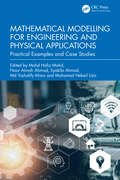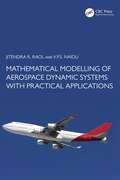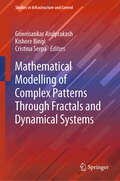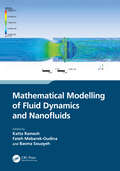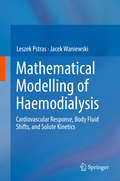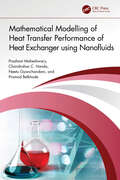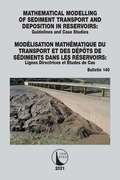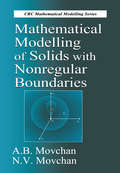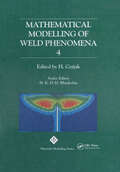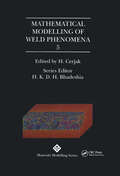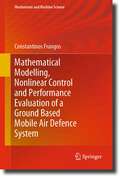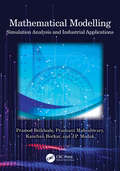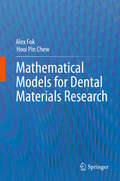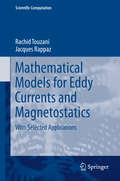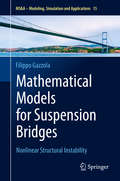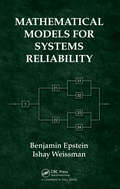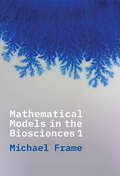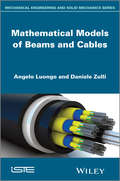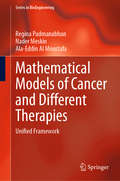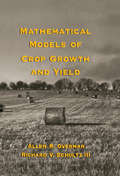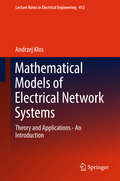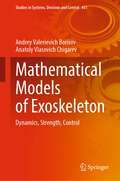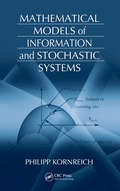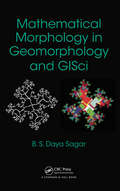- Table View
- List View
Mathematical Modelling for Engineering and Physical Applications: Practical Examples and Case Studies
by Mohd Hafiz Mohd Md Yushalify Misro Syakila Ahmad Noor Atinah Ahmad Mohamad Hekarl UzirThis edited volume from mathematical modelling experts employs a structured approach to showcase the latest research and provide a comprehensive guide to the principles, techniques and practical applications of mathematical modelling in the fields of engineering and the physical sciences.Readers will gain an insight into the fundamentals of mathematical modelling, its application in engineering and the physical sciences, recent advances in the field, real-world case studies and challenges and future directions in the field. The book first introduces readers to the fundamentals of mathematical modelling, including the definition, scope and steps involved in the modelling process. Mathematical tools and techniques relevant to modelling are explained. The book then addresses the application of mathematical modelling in engineering and the physical sciences. It covers various domains, such as mechanical, biomedical, chemical, computer and environmental engineering, as well as green energy, physics and other physical science applications. Furthermore, the book explores the integration of data-driven approaches, leveraging the power of big data and analytics to enhance modelling capabilities. Through real-life case studies, readers gain practical insights into how mathematical modelling is applied in various industries and scientific disciplines. These case studies analyse the modelling process, challenges faced and outcomes achieved. Readers will gain a solid foundation to develop effective mathematical models and apply them to solve complex engineering and physical problems. This foundation will also enable them to tackle problems and make informed decisions in their own projects. Finally, readers will be able to anticipate and adapt to evolving technologies and stay ahead in their respective fields.This book is a valuable resource primarily for undergraduate and graduate students seeking a comprehensive guide to this important discipline. Researchers, engineers and scientists will also benefit from the discussions within. Overall, the book empowers readers with the knowledge, skills and practical insights to effectively apply mathematical modelling in engineering and the physical sciences.
Mathematical Modelling of Aerospace Dynamic Systems with Practical Applications
by Jitendra R. Raol V.P.S. NaiduMathematical Modelling of Aerospace Dynamic Systems with Practical Applications provides mathematical models for several aerospace dynamic systems: aircraft, rotorcraft, missiles, unmanned aerial vehicles (UAVs), mini air vehicles (MAVs), autonomous underwater vehicles (AUWVs), and satellite-coordinate systems.Presenting the use of mathematical models for analysis, prediction, and control of these systems, this book discusses numerous applications in aircraft/helicopter parameter estimation, guidance and navigation of these vehicles, underwater object search, aerial terrain mapping, and satellite orbit determination. It explains path planning with obstacle avoidance, object occlusion detection and tracking, and multisensory target tracking and sensor data fusion.This book is intended for senior undergraduate mechanical and aerospace engineering students taking courses in aerospace systems and dynamics, flight dynamics and control, and dynamical systems and estimation.Instructors will be able to utilize a Solutions Manual and Figure Slides for their course.
Mathematical Modelling of Complex Patterns Through Fractals and Dynamical Systems (Studies in Infrastructure and Control)
by Kishore Bingi Gowrisankar Arulprakash Cristina SerpaThis book offers a wide range of interesting correlations beyond the domains of dynamical systems, complex systems, and fractal geometry. Exploring complex systems and their properties using the fractal approaches, this book provides initial solutions for new areas where fractal theory has yet to verify itsexpertise. Further, the book focusses on the latest scientific interest and illustrates general fractal theory in multidisciplinary areas such as computer science, electronics engineering, electrical engineering, bioengineering, biomedical, quantum physics and fluid dynamics research. This edited book is designed for professionals in the field of mathematics, computer science and physics, and even for non-specialists to help understand the concepts of fractals in nonlinear dynamical systems and complex systems while offering applications for researchers in the pure as well as in the applied background of science andengineering.
Mathematical Modelling of Fluid Dynamics and Nanofluids
by Katta Ramesh Fateh Mebarek-Oudina Basma SouayehMathematical Modelling of Fluid Dynamics and Nanofluids serves as a comprehensive resource for various aspects of fluid dynamics simulations, nanofluid preparation, and numerical techniques.The book examines the practical implications and real-world applications of various concepts, including nanofluids, magnetohydrodynamics, heat and mass transfer, and radiation. By encompassing these diverse domains, it offers readers a broad perspective on the interconnectedness of these fields.The primary audience for this book includes researchers and graduate students who possess a keen interest in interdisciplinary studies within the realms of fluid dynamics, nanofluids, and biofluids. Its content caters to those who wish to deepen their knowledge and tackle complex problems at the intersection of these disciplines.
Mathematical Modelling of Haemodialysis: Cardiovascular Response, Body Fluid Shifts, and Solute Kinetics
by Leszek Pstras Jacek WaniewskiBeginning with an introduction to kidney function, renal replacement therapies, and an overview of clinical problems associated with haemodialysis, this book explores the principles of the short-term baroreflex regulation of the cardiovascular system and the mechanisms of water and solute transport across the human body from a mathematical model perspective. It synthesizes theoretical physiological concepts and practical aspects of mathematical modelling needed for simulation and quantitative analysis of the haemodynamic response to dialysis therapy.Including an up-to-date review of the literature concerning the modelled physiological mechanisms and processes, the book serves both as an overview of transport and regulatory mechanisms related to the cardiovascular system and body fluids and as a useful reference for the study and development of mathematical models of dynamic physiological processes.Mathematical Modelling of Haemodialysis: Cardiovascular Response, Body Fluid Shifts, and Solute Kinetics is intended for researchers and graduate students in biomedical engineering, physiology, or medicine interested in mathematical modelling of cardiovascular dynamics and fluid and solute transport across the human body, both under physiological conditions and during haemodialysis therapy.
Mathematical Modelling of Heat Transfer Performance of Heat Exchanger using Nanofluids
by Pramod Belkhode Prashant Maheshwary Chandrahas C. Handa Neetu GyanchandaniThe book presents a detailed discussion of nanomaterials, nanofluids and application of nanofluids as a coolant to reduce heat transfer. It presents a detailed approach to the formulation of mathematical modelling applicable to any type of case study with a validation approach and sensitivity and optimization. Covers the aspects of formulation of mathematical modelling with optimization and sensitivity analysis. Presents a case study based on heat transfer improvement and performs operations using nanofluids. Examines the analysis of experimental data by the formulation of a mathematical model and correlation between input data and output data. Illustrates heat transfer improvement of heat exchangers using nanofluids through the mathematical modelling approach. Discusses applications of nanofluids in cooling systems. This book discusses the aspect of formulation of mathematical modelling with optimization and sensitivity analysis. It further presents a case study based on the heat transfer improvement and performing operations using nanofluids. The text covers sensitivity analysis and analysis from the indices of the model. It also discusses important concepts such as nanomaterials, applications of nanomaterials, and nanofluids. It will serve as an ideal reference text for senior undergraduate, and graduate students in fields including mechanical engineering, chemical engineering, aerospace engineering, industrial engineering, and manufacturing engineering.
Mathematical Modelling of Sediment Transport and Deposition in Reservoirs - Guidelines and Case Studies / Modélisation Mathématique du Transport et des Dépôts de Sédiments dans les Réservoirs - Lignes Directrices et Études de Cas (ICOLD Bulletins Series #140)
by Cigb IcoldAs reservoir sedimentation has proven to be a serious problem in South Africa, research in this field has been ongoing for more than 70 years. This publication emanates from extensive research which has been undertaken over the past 30 years with the support of the South African Department of Water and Sanitation as well as the South African Water Research Commission. A great deal of information has fortunately also been obtained from China. Given the universal nature of hydraulic formulae it is not surprising, yet gratifying, that Chinese and South African data generally conform to the same mathematical relationships. This indicates that these relationships should be applicable in other countries as well. Much of the information contained here has been condensed from a more comprehensive publication. This ICOLD Bulletin follows on Bulletin 115 “Dealing with reservoir sedimentation”, which gave guidelines for management of reservoirs to limit sedimentation. The guidelines on mathematical modelling of sediment transport dynamics in reservoirs in this document can be used during the planning and design of new dams, as well as for the management of existing dams. Comme la sédimentation dans les réservoirs s'est avérée être un problème sérieux en Afrique du Sud, la recherche dans ce domaine est en cours depuis plus de 70 ans. Cette publication émane de la recherche étendue qui a été menée au cours des 30 dernières années avec l'appui du ministère sud-africain de l’eau et de l’assainissement, ainsi que de la commission sud-africaine de recherche sur l'eau. Un grand nombre d'informations ont également été obtenues de la part de la Chine. Étant donné le caractère universel de formules hydrauliques, il n'est pas surprenant, mais très gratifiant, que les données chinoises et sud-africaines se conforment généralement aux mêmes relations mathématiques. Ceci indique que ces relations devraient être applicables dans d'autres pays également. Une grande partie de l'information contenue ici a été condensée à partir d'une publication plus complète. Ce bulletin CIGB fait suite au bulletin 115 "Traité sur la sédimentation dans les réservoirs", qui a donné des directives pour la gestion des réservoirs en vue de limiter la sédimentation. Les directives sur la modélisation mathématique de la dynamique de transport des sédiments dans les réservoirs de ce présent document peuvent être utilisées lors de la planification et la conception de nouveaux barrages et pour la gestion des barrages existants.
Mathematical Modelling of Solids with Nonregular Boundaries (Mathematical Modeling Ser. #3)
by A.B. Movchan N.V. MovchanMathematical Modelling of Solids with Nonregular Boundaries demonstrates the use of asymptotic methods and other analytical techniques for investigating problems in solid mechanics. Applications to solids with nonregular boundaries are described in detail, providing precise and rigorous treatment of current methods and techniques. The book addresses problems in fracture mechanics of inhomogeneous media and illustrates applications in strength analysis and in geophysics. The rigorous approach allows the reader to explicitly analyze the stress-strain state in continuous media with cavities or inclusions, in composite materials with small defects, and in elastic solids with sharp inclusions. Effective asymptotic procedures for eigenvalue problems in domains with small defects are clearly outlined, and methods for analyzing singularly perturbed boundary value problems are examined.Introductory material is provided in the first chapter of Mathematical Modelling of Solids with Nonregular Boundaries, which presents a survey of relevant and necessary information, including equations of linear elasticity and formulations of the boundary value problems. Background information - in the form of definitions and general solutions - is also provided on elasticity problems in various bounded and unbounded domains. This book is an excellent resource for students, applied scientists, and engineers.
Mathematical Modelling of Weld Phenomena: No. 4
by H. CerjakContains the papers presented at the fourth International Seminar "Numerical Analysis of Weldability" held in September 1997 at Schloss Seggau near Graz, Austria.
Mathematical Modelling of Weld Phenomena: No. 5
by H. CerjakContains the papers presented at the fourth International Seminar "Numerical Analysis of Weldability" held in September 1997 at Schloss Seggau near Graz, Austria.
Mathematical Modelling, Nonlinear Control and Performance Evaluation of a Ground Based Mobile Air Defence System (Mechanisms and Machine Science #76)
by Constantinos FrangosIn this book, the author deals with the mathematical modelling, nonlinear control and performance evaluation of a conceptual anti-aircraft gun based mobile air defence system engaging an attacking three-dimensional aerial target.This book is of interest to academic faculty, graduate students and industry professionals working in the fields of mathematical modelling and control, ground vehicles, mobile air defence systems and other related topics.
Mathematical Modelling: Simulation Analysis and Industrial Applications
by J.P. Modak Pramod Belkhode Prashant Maheshwary Kanchan BorkarThis book investigates human–machine systems through the use of case studies such as crankshaft maintenance, liner piston maintenance, and biodiesel blend performance. Through mathematical modelling and using various case studies, the book provides an understanding of how a mathematical modelling approach can assist in working out problems in any industrial-oriented activity. Mathematical Modelling: Simulation Analysis and Industrial Applications details a data analysis approach using mathematical modelling sensitivity. This approach helps in the processing of any type of data and can predict the result so that based on the result, the activity can be controlled by knowing the most influencing variables or parameters involved in the phenomenon. This book helps to solve field and experimental problems of any research activity using a data-based modelling concept to assist in solving any type of problem. Students in manufacturing, mechanical, and industrial engineering programs will find this book very useful. This topic has continued to advance and incorporate new concepts so that the manufacturing field continues to be a dynamic and exciting field of study.
Mathematical Models for Dental Materials Research
by Alex Fok Hooi Pin ChewThis book presents a mechanistic approach—mathematical modeling—for carrying out dental materials research. This approach allows researchers to go beyond the null hypothesis and obtain a solution that is more general and therefore predictive for conditions other than those considered in a study. Hence it can be used either on its own or to complement the commonly used statistical approach. Through a series of practical problems with wide-ranging application, the reader will be guided on:How to construct a mathematical model for the behavior of dental materials by making informed assumptions of the physical, chemical, or mechanical situationHow to simplify the model by making suitable simplificationsHow to calibrate the model by calculating the values of key parameters using experimental resultsHow to refine the model when there are discrepancies between predictions and experimentsOnly elementary calculus is required to follow the examples and all the problems can be solved by using MS Excel© spreadsheets.This is an ideal book for dental materials researchers without a strong mathematical background who are interested in applying a more mechanistic approach to their research to give deeper insight into the problem at hand. Advance praise for Mathematical Models for Dental Materials Research:“This is a nice addition for research students on how to conduct their work and how to manage data analysis. It brings together a number of important aspects of dental materials investigations which has been missing in the literature. The practical examples make it much easier to understand.” – Michael F. Burrow, Clinical Professor in Prosthodontics, The University of Hong Kong“The great strengths of this volume are the real world examples of dental materials research in the successive chapters. In turn, this is an outcome of the outstanding expertise of both authors. I warmly recommend this book to the dental biomaterials community worldwide.” – David C. Watts, Professor of Biomaterials Science, University of Manchester, UK
Mathematical Models for Eddy Currents and Magnetostatics
by Rachid Touzani Jacques RappazThis monograph addresses fundamental aspects of mathematical modeling and numerical solution methods of electromagnetic problems involving low frequencies, i. e. magnetostatic and eddy current problems which are rarely presented in the applied mathematics literature. In the first part, the authors introduce the mathematical models in a realistic context in view of their use for industrial applications. Several geometric configurations of electric conductors leading to different mathematical models are carefully derived and analyzed, and numerical methods for the solution of the obtained problems are given. Related issues such as convergence of the approximations and error estimates are discussed. The second part of the monograph presents various coupled problems that involve eddy current or magnetostatic problems, in particular magneto-hydrodynamic problems and magnetic shaping problems concerning the melt flow of electrically conducting metals, induction heating processes, inductively coupled plasmas and ferromagnetic screening modeling. The presentation of each model comes with numerical illustration from industrial applications.
Mathematical Models for Suspension Bridges
by Filippo GazzolaThis work provides a detailed and up-to-the-minute survey of the various stability problems that can affect suspension bridges. In order to deduce some experimental data and rules on the behavior of suspension bridges, a number of historical events are first described, in the course of which several questions concerning their stability naturally arise. The book then surveys conventional mathematical models for suspension bridges and suggests new nonlinear alternatives, which can potentially supply answers to some stability questions. New explanations are also provided, based on the nonlinear structural behavior of bridges. All the models and responses presented in the book employ the theory of differential equations and dynamical systems in the broader sense, demonstrating that methods from nonlinear analysis can allow us to determine the thresholds of instability.
Mathematical Models for Systems Reliability
by Benjamin Epstein Ishay WeissmanEvolved from the lectures of a recognized pioneer in developing the theory of reliability, Mathematical Models for Systems Reliability provides a rigorous treatment of the required probability background for understanding reliability theory.This classroom-tested text begins by discussing the Poisson process and its associated probability
Mathematical Models in the Biosciences I
by Michael FrameAn award-winning professor’s introduction to essential concepts of calculus and mathematical modeling for students in the biosciences This is the first of a two-part series exploring essential concepts of calculus in the context of biological systems. Michael Frame covers essential ideas and theories of basic calculus and probability while providing examples of how they apply to subjects like chemotherapy and tumor growth, chemical diffusion, allometric scaling, predator-prey relations, and nerve impulses. Based on the author’s calculus class at Yale University, the book makes concepts of calculus more relatable for science majors and premedical students.
Mathematical Models of Beams and Cables
by Angelo Luongo Daniele ZulliNonlinear models of elastic and visco-elastic onedimensional continuous structures (beams and cables) are formulated by the authors of this title. Several models of increasing complexity are presented: straight/curved, planar/non-planar, extensible/inextensible, shearable/unshearable, warpingunsensitive/ sensitive, prestressed/unprestressed beams, both in statics and dynamics. Typical engineering problems are solved via perturbation and/or numerical approaches, such as bifurcation and stability under potential and/or tangential loads, parametric excitation, nonlinear dynamics and aeroelasticity. Contents 1. A One-Dimensional Beam Metamodel.2. Straight Beams.3. Curved Beams.4. Internally Constrained Beams.5. Flexible Cables.6. Stiff Cables.7. Locally-Deformable Thin-Walled Beams.8. Distortion-Constrained Thin-Walled Beams.
Mathematical Models of Cancer and Different Therapies: Unified Framework (Series in BioEngineering)
by Regina Padmanabhan Nader Meskin Ala-Eddin Al MoustafaThis book provides a unified framework for various currently available mathematical models that are used to analyze progression and regression in cancer development, and to predict its dynamics with respect to therapeutic interventions. Accurate and reliable model representations of cancer dynamics are milestones in the field of cancer research. Mathematical modeling approaches are becoming increasingly common in cancer research, as these quantitative approaches can help to validate hypotheses concerning cancer dynamics and thus elucidate the complexly interlaced mechanisms involved. Even though the related conceptual and technical information is growing at an exponential rate, the application of said information and realization of useful healthcare devices are lagging behind.In order to remedy this discrepancy, more interdisciplinary research works and course curricula need to be introduced in academic, industrial, and clinical organizations alike. To that end, this book reformulates most of the existing mathematical models as special cases of a general model, allowing readers to easily get an overall idea of cancer dynamics and its modeling. Moreover, the book will help bridge the gap between biologists and engineers, as it brings together cancer dynamics, the main steps involved in mathematical modeling, and control strategies developed for cancer management. This also allows readers in both medical and engineering fields to compare and contrast all the therapy-based models developed to date using a single source, and to identify unexplored research directions.
Mathematical Models of Crop Growth and Yield (Books In Soils, Plants, And The Environment Ser. #Vol. 91)
by Allen R. Overman Richard V. Scholtz IIIHighlighting effective, analytical functions that have been found useful for the comparison of alternative management techniques to maximize water and nutrient resources, this reference describes the application of viable mathematical models in data analysis to increase crop growth and yields. Featuring solutions to various differential equations,
Mathematical Models of Electrical Network Systems
by Andrzej KłosThis book is for all those who are looking for a non-conventional mathematical model of electrical network systems. It presents a modern approach using linear algebra and derives various commonly unknown quantities and interrelations of network analysis. It also explores some applications of algebraic network model of and solves some examples of previously unsolved network problems in planning and operation of network systems. Complex mathematical aspects are illustrated and described in a way that is understandable for non-mathematicians. Discussing interesting concepts and practically useful methods of network analysis, it is a valuable resource for lecturers, students, engineers
Mathematical Models of Exoskeleton: Dynamics, Strength, Control (Studies in Systems, Decision and Control #431)
by Andrey Valerievich Borisov Anatoly Vlasovich ChigarevThis book presents the current state of the problem of describing the musculoskeletal system of a person. Models of the destruction of the endoskeleton and the restoration of its functions using exoskeleton are presented. A description is given of new approaches to modeling based on the use of weightless rods of variable length with concentrated masses. The practical application to the tasks of numerical simulation of the movements of the musculoskeletal system of a person is described. Exoskeleton models with variable-length units based on absolutely hard sections and sections that change their telescopic type length have been developed.The book is intended for specialists in the field of theoretical mechanics, biomechanics, robotics and related fields. The book will be useful to teachers, as well as graduate students, undergraduates and senior students of higher educational institutions, whose research interests lie in the modeling of anthropomorphic biomechanical systems.
Mathematical Models of Information and Stochastic Systems
by Philipp KornreichFrom ancient soothsayers and astrologists to today’s pollsters and economists, probability theory has long been used to predict the future on the basis of past and present knowledge. Mathematical Models of Information and Stochastic Systems shows that the amount of knowledge about a system plays an important role in the mathematical models used to foretell the future of the system. It explains how this known quantity of information is used to derive a system’s probabilistic properties. After an introduction, the book presents several basic principles that are employed in the remainder of the text to develop useful examples of probability theory. It examines both discrete and continuous distribution functions and random variables, followed by a chapter on the average values, correlations, and covariances of functions of variables as well as the probabilistic mathematical model of quantum mechanics. The author then explores the concepts of randomness and entropy and derives various discrete probabilities and continuous probability density functions from what is known about a particular stochastic system. The final chapters discuss information of discrete and continuous systems, time-dependent stochastic processes, data analysis, and chaotic systems and fractals. By building a range of probability distributions based on prior knowledge of the problem, this classroom-tested text illustrates how to predict the behavior of diverse systems. A solutions manual is available for qualifying instructors.
Mathematical Morphology in Geomorphology and GISci
by Behara Seshadri Daya SagarMathematical Morphology in Geomorphology and GISci presents a multitude of mathematical morphological approaches for processing and analyzing digital images in quantitative geomorphology and geographic information science (GISci). Covering many interdisciplinary applications, the book explains how to use mathematical morphology not only to perform
Mathematical Morphology in Image Processing (Optical Science and Engineering #1)
by Edward DoughertyPresents the statistical analysis of morphological filters and their automatic optical design, the development of morphological features for image signatures, and the design of efficient morphological algorithms. Extends the morphological paradigm to include other branches of science and mathematics.;This book is designed to be of interest to optical, electrical and electronics, and electro-optic engineers, including image processing, signal processing, machine vision, and computer vision engineers, applied mathematicians, image analysts and scientists and graduate-level students in image processing and mathematical morphology courses.
